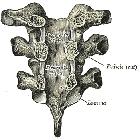Ligamenta flava


The ligamenta flava (singular: ligamentum flavum) are paired ligaments which run between adjacent laminae of the vertebral bodies and are present from C2/3 to the sacrum. Above the C2/3 level, the equivalent structures are known as the posterior atlanto-occipital membrane between the skull base and C1 and between C1 and C2 may be known as the posterior atlanto-axial membrane. The ligamenta flava form part of the posterior ligamentous complex of the vertebral column.
Gross anatomy
- paired, yellowish, elastic ligament
- forms part of the posterior border of the spinal canal
- relatively thin in the cervical spine, progressively becoming thickest in the lumbar spine
- broad base along the lamina from the facet joints to base of the spinous process
- attaches from the front of the upper lamina to the back of the lower lamina
- in the lumbar region, it runs laterally, covering the anterior aspect of the facet joints.
Relations
- anterolateral: intervertebral foramen and contents (spinal nerve roots, segmental arteries, recurrent meningeal nerves, communicating veins between internal and external venous plexus)
- anteromedial: spinal cord and meninges
- posterolateral: lamina and facet joints
- posteromedial: spinous process, interspinous ligament, venous connection between internal and external vertebral venous plexuses
Innervation
- superficial: medial branch of dorsal roots of spinal nerves
- deep: sinuvertebral nerves (recurrent meningeal nerves)
History and etymology
Flavum is Latin for yellow, referring to the color of the ligament.
Related pathology
Siehe auch:

 Assoziationen und Differentialdiagnosen zu Ligamenta flava:
Assoziationen und Differentialdiagnosen zu Ligamenta flava:

